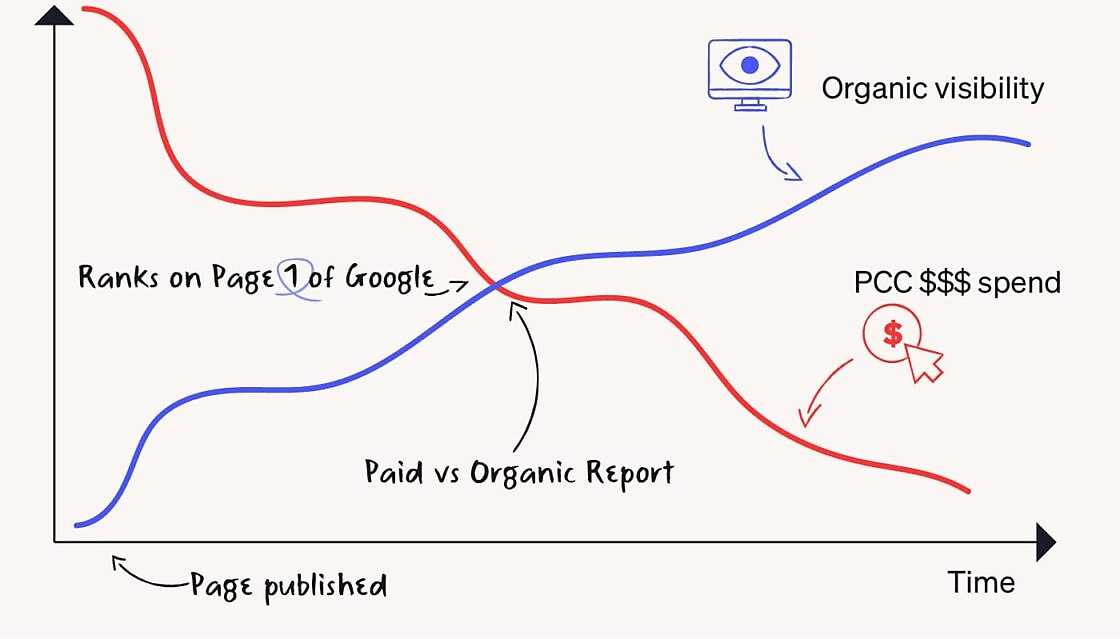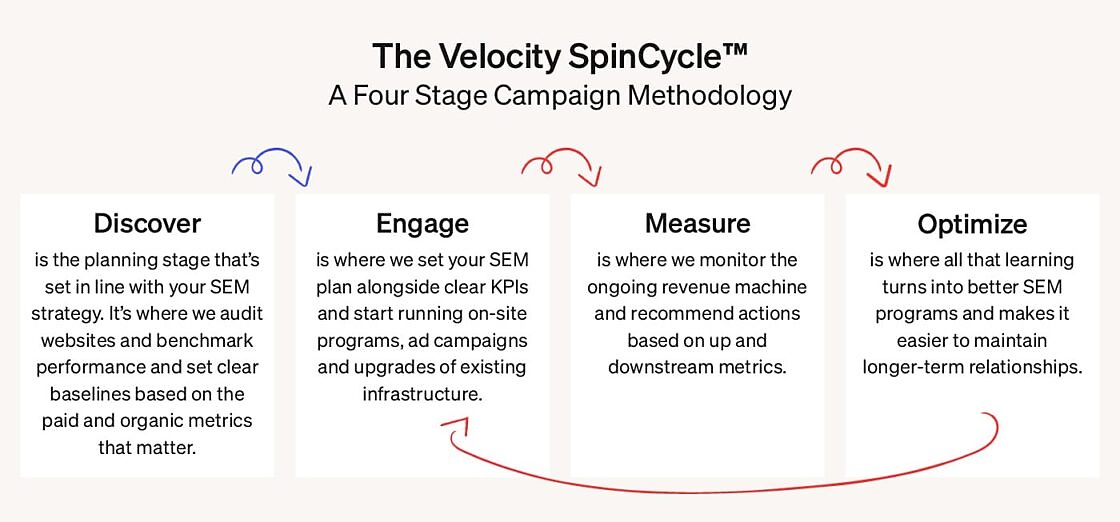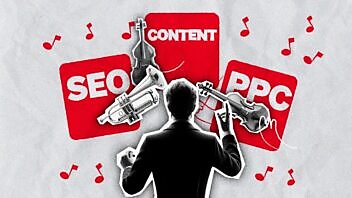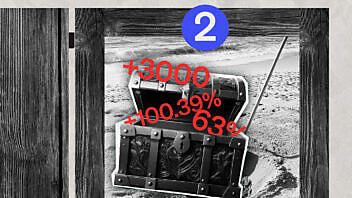This is one of a series of blogs about the changing B2B Go-To-Market landscape. You can check out the others in the series at the bottom of this piece.
The level of change Google is imposing on the search space right now is making B2B SEM and SEO harder — both individually, and (more dangerously) as a connected strategy.
A perfect storm of new changes (that we’ll explore in a second) means it’s both harder for companies to rank organically, and more complicated to make up the shortfall with PPC.
Here’s the short version:
- Paid search is getting more expensive
- SERPs are accelerating towards an AI-powered, clickless experience
- As a result, the organic space is shrinking
The risk here is that SEM and SEO teams get overwhelmed by change and try to tackle these challenges in silos rather than in partnership.
This blog explores how the volatility of the search environment today is an opportunity for SEM and SEO specialists to deepen their collaboration — and why teams that work more closely together will win.
We’re going to look at:
- How organic and PPC are each getting more complicated
- Why the best model for SEM and SEO collaboration involves a seesaw
- What integrated SEM looks like up close
- The three steps to successfully integrate SEM and SEO
Ready? Let’s go.
Why is organic (or SEO) so difficult right now?
- It’s harder to gain organic visibility
Despite endless budget and effort, you still can’t rank on Page 1 for your targeted terms - Conversion-driving traffic is hard to attract
Traffic that doesn’t convert to pipeline can come from irrelevant or top-of-funnel terms — so you get mostly tire kickers who aren’t ready to buy - Limited growth from non-branded terms
Most of your search traffic may come from product or brand terms, meaning those who already intended to find you, and not new audiences - Junk traffic from unstrategic terms
A non-insignificant proportion of traffic comes from random search terms unrelated to your service or product offering, such as a sporadic blog article you penned in the past.
Why has PPC become so much harder?
- Precision in lead targeting
It’s harder to be precise with your lead targeting in paid media than in organic because search engines are increasing SERP paid ad space, leading to more competition, and less alignment with SEO strategies that may span other areas of the search engine result page (like local, image or video). - Cost pressures
Google is increasing search cost per click (CPC) by an average of 19%, pushing up ad spend by 17% in the US alone in the final quarter of 2023. Because budgets are stretched enough as it is, this escalation in costs comes at a time when efficiency in ad spending is more critical than ever. - Automation and control
Google’s push towards automation under the guise of optimization can eat up budgets without contributing material gains. Automation ostensibly frees advertisers to focus on crafting the quality messages rather than micromanaging bids. But in reality it’s replacing established best practices with murky bid optimization strategies that reduce control over your campaigns.
Some impacts of these changes are particularly challenging for B2B search marketers:
- Match type broadening: Google’s shift from ‘exact match’ to a looser ‘phrase match,’ and from ‘phrase match’ to ‘broad match,’ encourages the use of broader match types. For B2B firms with niche offerings, this wastes money when ads showing up for less relevant terms or those where intent differs.
- Low search volumes and automated bidding: B2B keywords often have low search volumes, meaning there’s insufficient data to effectively automate bidding, which complicates spending optimization.
- Demand capture vs. demand generation: While paid search excels at capturing existing demand (bidding on commercial intent keywords), it struggles with generating new demand.
SEM and SEO teams are scrambling to adapt to these challenges in silos — instead of solving things together.
The problem is that SEM and SEO should work like a seesaw — with paid tactics as a stepping stone to organic authority that eventually tips the fulcrum with value that outweighs the investment in SEM.
But these changes are creating an imbalance. The seesaw is overloaded with PPC tactics to make up the shortfall in organic visibility, with no plan to tip the balance in the other direction.
The result is an endless money pit — marketers spend more and more cash on less and less reliable leads.
So how can marketers rebuild organic visibility to rebalance the SEM/SEO seesaw?
The benefits of an organic-heavy SEM seesaw
Paid media is an important part of every search marketing B2B strategy, but the payoff when you balance it with strong organic tactics is huge:
- Improved cost-efficiency
By optimizing assets like landing pages with more relevant keywords, you can improve on-page quality scores and enhance ad relevance, reducing your paid advertising costs. - Increase speed to market and gain immediate visibility
PPC enables immediate traction and visibility for targeted keywords and audiences, complementing the gradual benefits of SEO, where visibility often develops over time. - Cost-effective visibility and engagement
The most cost-effective path to visibility is a long-term organic B2B marketing investment punctuated by bursts of targeted SEM for immediate engagement around key terms. Organic authority and targeted ads are a complementary pair that engage and nudge buyers across the whole whole funnel.

But this doesn’t happen overnight. It’s hard to tip the seesaw towards low-cost, high-quality organic leads — especially if your organic and paid teams aren’t working together.
Here’s an example of how a lack of collaboration between SEM and SEO teams makes leads worse and PPC more expensive (and conversely, how those improve when each side works together).
How better content lowers paid costs
Imagine you’re a third-party logistics service provider, and you’ve created a landing page to promote your rail freight service.
You name this page ‘rail transport’ and mention the keyword once or twice.
Your PPC team does a bit of keyword research, realizes the term ‘rail freight’ is much more closely aligned with your services, and creates a PPC ad and campaign on the term to send traffic to your Rail Transport page.
Seems fine, right?
The problem is twofold. First, ‘rail transport’ is too broad — it could refer to any kind of rail transport, like the one you and I travel on to work (sometimes, we assume). Second, your landing page hasn’t been optimized for terms related to ‘rail freight’, so search engines like Google don’t see it as very relevant for the terms you now wish to bid on.
Rail freight and rail transport are different things. Since Google doesn’t like when people create ads that send traffic to irrelevant pages, they’ll give your landing page a poor quality score (between 1 and 10, 10 being the best). The lower your quality score, the more your ads will cost.
Now let’s imagine things go better, because your SEO strategist shuffles across the office and helps you optimize your landing page with terms used in your ad campaign. This not only encourages Google to give you a better quality score — it also means they discount your CPC. Because of relevance.
Google’s Ads Quality Score is a formula that calculates the relationship between your ad relevance and landing page experience for your desired keywords. The higher your score, the cheaper your CPC becomes. And the effects are dramatic:
- Score 1 = increases CPC by 400.00%
- Score 2 = increases CPC by 150.00%
- Score 3 = increases CPC by 67.30%
- Score 4 = increases CPC by 25.00%
- Score 5 = Google’s benchmark
- Score 6 = increases CPC by 16.70%
- Score 7 = discounts CPC by 28.60%
- Score 8 = discounts CPC by 37.50%
- Score 9 = discounts CPC by 44.20%
- Score 10 = discounts CPC by 50.00%
So by optimizing pages for relevant keywords and combining this with relevant ad sequences, you could discount cost-per-click by up to 50%. Put simply, keyword optimized content + keyword optimized ads = cheaper PPC.
The antidote: an integrated SEM approach
The heart of this problem is that SEO and PPC teams are often siloed, despite working towards the same goal: To create as much high-quality pipeline and revenue as possible, at the lowest cost.
They often present different and conflicting reports and analyze different metrics, which tend to be upstream, rather than looking at the whole lead lifecycle (where it has to be in B2B).
Enter an integrated approach.
We’ve learned that integrating B2B SEM and SEO strategies supports a unified approach where both paid and organic efforts inform and enhance each other. This leads to smarter spending, better targeted campaigns, and a more coherent journey for potential customers.
In an integrated SEM approach, SEO and PPC teams share goals, data, and insights in order to develop innovative strategies that reduce waste and increase effectiveness.
That means practices like campaigns, analytics, SEO and marketing operations are all merged and interweaved under one project or strategy, working together towards a shared goal. Each team can have their own tactics and techniques, but are aligned on the same end goal.
Individually, they make pockets of your marketing better. But together, they focus and optimize your creative firepower around the activities, audiences, messages, channels and tactics that drive your business forward.
This informs more relevant content, website pages, ads and overall campaigns, which is super important for both quality and cost.
But what does this look like in practice? We’ve created a three-step approach to build a sustainable integrated SEM approach.
4 steps to a successful integrated SEM approach
- Discover
Kick off with a shared audit to make sure you’re aligned with a B2B strategy and working towards specific KPIs.
In a discovery audit, you should be doing the following things:
- Checking to see that your ICP is correct and up to date, and making sure your content is relevant to that ICP. Content that matches the tongue, tone and tastes of your audience and related to your product stack and head terms. Relevant, relatable and helpful.
- Review your website to make sure that it’s future-proofed with best practices and built to last, including upgraded Core Web Vital scores, UX and crawler fixes, and international targeting.
- Check your existing ads set up to ensure that they’re set up correctly, targeting the right keywords, displaying in the right locations at the right time of day, in the right languages and making sure your audience spend is correct.
The answers to these questions will help you pinpoint what the solution to your problem is down the line.
- Engage
In the Engage phase, the strategy moves from the initial discovery and audit to a plan of action. At Velocity, we call this a blueprint:
Shared research and planning: Start by understanding a shared keyword strategy that focuses on your audience and the issues they are looking to resolve, which should be married to the solution you provide. Are there keywords to improve organic ranking or SEO clusters you should also include in a PPC campaign? What content do you have for the SEO clusters and are they relevant to PPC? For commercial intent keywords, do you have relevant landing pages set up for target action? etc.
Infrastructure and system setup: Ensure the website’s infrastructure supports SEM strategies by addressing technical SEO issues like loading speed, responsiveness and device adaptability. Set up ads accounts with a cohesive B2B SEM strategy, incorporating revisions before full deployment.
Content structuring: Outline content and landing pages to support the user journey from awareness to conversion. Align content with identified keywords and user search intent, ensuring it engages users at different decision-making stages.
Integrated management and execution: Develop execution strategies showing how various SEM tactics combine for optimal results. Establish a unified team approach with integrated account management processes, including a 90-day plan for initial delivery and support.
- Measure
The results of an integrated approach then feeds into your reporting in the form of a paid and organic SEM report.
This involves bringing data points together to explore the balance of your hubs and where changes need to come.
Which means you get answers to questions like “should I bid on my brand terms?” or “which keywords should I not bid on?” You also get to:
- Identify long-tail keywords your ICP is searching for outside of just product terms
- Validate the content you have on site already, and how visible it is, which showcases gaps
- See opportunities where you can start tapering off paid campaigns when organic SEO starts to gain visibility on page one.
- See where you can build new landing pages based on newly discovered paid keywords
- Understand engagement rates and conversion rates between both channels
- See how to refine and integrate bidding strategy and help save costs by pulling back on ads, such as if you rank highly in organic.
- Optimize
The final stage is to continuously track, analyze and optimize your SEM campaigns based on the performance metrics agreed in your blueprint’s benchmarking phase.
Although “final” is a bit of a misnomer — the optimization moves you identify should loop back around to the Engage stage as you kick off a new campaign, armed with fresh insights to boost your effectiveness.
This is where you adjust your strategy and tactics as needed to enhance visibility, boost engagement and improve conversions over time.
If you’re overwhelmed by actionable data points, first of all: congratulations, and second, don’t be afraid to prioritize high-return areas. This is a marathon, not a sprint — aim for low-hanging, high-value fruit.

In essence, through integrating B2B SEM and using smart collaboration, you get one step closer to solving the B2B performance marketing problem.
As an agency specializing in B2B SEM, we help clients with this problem all the time.
If you need help breaking through the Google ceiling (and aren’t going to be impatient about it) give us a call.
Published in:
b2b-marketing
b2b-seo
digital-marketing

Enjoyed this article?
Take part in the discussion





















Comments
There are no comments yet for this post. Why not be the first?